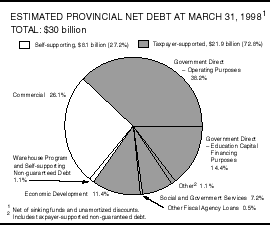The following chart provides a breakdown by category of estimated provincial net debt outstanding at March 31, 1998. Further details are provided in Tables C2 and H7.

Taxpayer-Supported Debt:
Provincial government direct debt funds government operations, including refinancing of maturing debt and other financing transactions, as well as capital advances for the construction of school and post-secondary education facilities. These advances are amortized over the expected life of the underlying assets.
Economic development Crown corporations and agencies finance ferry terminal and fleet expansions, public transit construction and maintenance projects, and highway construction projects around the province. Although these corporations and agencies sell services directly to the public or receive dedicated revenue, their revenue may not totally cover their operating expenses. In these cases, the government may provide grants or other forms of assistance.
Social and government service Crown corporations and agencies finance construction of health facilities, justice facilities, and other accommodation requirements. Debt service requirements are met through provincial grants or rental payments and, for hospitals, partly through local property taxes.
Other fiscal agency loans finance the construction and maintenance of post-secondary residence and parking facilities. Debt service requirements are met through user fees.
Loan guarantees to private sector firms and individuals are provided by the provincial government through various programs including student financial assistance. Loan guarantees do not represent direct obligations of the government except in the event of default by the borrowers who received the guarantees.
Non-guaranteed debt consists primarily of mortgages which were incurred by a government body without a provincial guarantee. Debt service requirements are met through user fees.
Self-Supporting Debt:
Commercial Crown corporations finance the construction and maintenance of electricity transmission lines and generating facilities, a rail system and dock facilities, and a forest products mill. These entities are self-sufficient as they generate revenue from the sale of services at commercial rates and pay their own operating expenses, including debt service charges.
Warehouse borrowing program takes advantage of market opportunities to borrow money in advance of actual requirements. This debt will eventually be allocated to either the provincial government or its Crown corporations and agencies to meet future requirements.
Non-guaranteed debt represents debt which was incurred by a self-supporting government body without a provincial guarantee. Debt service requirements are met through sales of services at commercial rates.